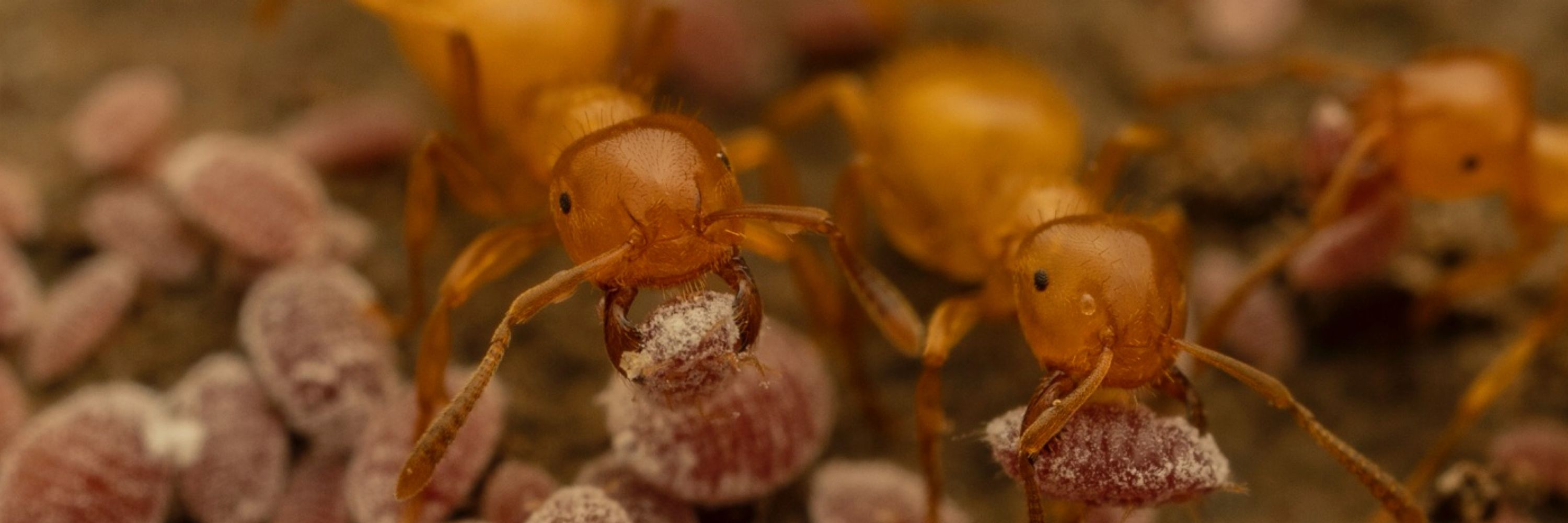
Daniel Kronauer
@danielkronauer.bsky.social
PI @Rockefeller University. Investigator @HHMI. Instigator of clonal raider ant project #CRAP. 🐜 Evolution, Behavior & Neuroscience. Posts science and photography. 🧠 📸
https://www.rockefeller.edu/research/2280-kronauer-laboratory/
https://www.rockefeller.edu/research/2280-kronauer-laboratory/
Lab members are once again outdoing themselves at the annual @rockefeller.edu pumpkin carving contest. This year’s submission: an ant farm pumpkin with a carpenter ant colony digging to find a chamber of prey Drosophila.


October 29, 2025 at 4:49 PM
Lab members are once again outdoing themselves at the annual @rockefeller.edu pumpkin carving contest. This year’s submission: an ant farm pumpkin with a carpenter ant colony digging to find a chamber of prey Drosophila.
New preprint from the lab: A reference brain for the clonal raider ant.
With this resource, which is based on 40 individual brains, you can register and compare all kinds of samples in a common space. It comes with lots of detailed protocols and a user-friendly GUI.
www.biorxiv.org/content/10.1...
With this resource, which is based on 40 individual brains, you can register and compare all kinds of samples in a common space. It comes with lots of detailed protocols and a user-friendly GUI.
www.biorxiv.org/content/10.1...
October 17, 2025 at 5:35 PM
New preprint from the lab: A reference brain for the clonal raider ant.
With this resource, which is based on 40 individual brains, you can register and compare all kinds of samples in a common space. It comes with lots of detailed protocols and a user-friendly GUI.
www.biorxiv.org/content/10.1...
With this resource, which is based on 40 individual brains, you can register and compare all kinds of samples in a common space. It comes with lots of detailed protocols and a user-friendly GUI.
www.biorxiv.org/content/10.1...
Here is a confocal stack of a clonal raider ant antenna from first author and FISHerman extraordinaire Giacomo Glotzer. You can see the densely packed cell bodies of olfactory sensory neurons, along with fluorescent signal from two different odorant receptors and an intergenic region.
September 19, 2025 at 3:44 PM
Here is a confocal stack of a clonal raider ant antenna from first author and FISHerman extraordinaire Giacomo Glotzer. You can see the densely packed cell bodies of olfactory sensory neurons, along with fluorescent signal from two different odorant receptors and an intergenic region.
Finally, an ant photo from my recent Kenya trip. On Mount Kenya, you pass through a zone of pristine rainforest, which is where I’ve previously worked on army ants. There are other cool ants though, and here’s an example. The dark sphere in this tree is a carton nest of Crematogaster acrobat ants.

August 24, 2025 at 12:02 AM
Finally, an ant photo from my recent Kenya trip. On Mount Kenya, you pass through a zone of pristine rainforest, which is where I’ve previously worked on army ants. There are other cool ants though, and here’s an example. The dark sphere in this tree is a carton nest of Crematogaster acrobat ants.
A black panther! Melanistic leopards are extremely rare in Africa, and seeing one on our recent trip to Kenya was a dream come true. We were able to spend an hour right before sunset around this marvelous creature while staying at Mpala Research Centre in Laikipia.

August 17, 2025 at 7:05 PM
A black panther! Melanistic leopards are extremely rare in Africa, and seeing one on our recent trip to Kenya was a dream come true. We were able to spend an hour right before sunset around this marvelous creature while staying at Mpala Research Centre in Laikipia.
Sleeping hippos look like they’re smiling. Here, a group is resting on a river bank at Mpala Research Centre while being attended to by red-billed oxpeckers. These birds eat ticks off of large mammals, but also drink blood directly from wounds. 🦛 🇰🇪

August 15, 2025 at 9:04 PM
Sleeping hippos look like they’re smiling. Here, a group is resting on a river bank at Mpala Research Centre while being attended to by red-billed oxpeckers. These birds eat ticks off of large mammals, but also drink blood directly from wounds. 🦛 🇰🇪
The Grévy's zebra (Equus grevyi) is the largest and, sadly, rarest of the three zebra species. Luckily, Mpala Research Centre is home to a decent number of Grévy's zebras, which are studied as part of a long-term monitoring program:
www.mpalalive.org/field_guide/...
mpala.org/princeton-ze...
www.mpalalive.org/field_guide/...
mpala.org/princeton-ze...
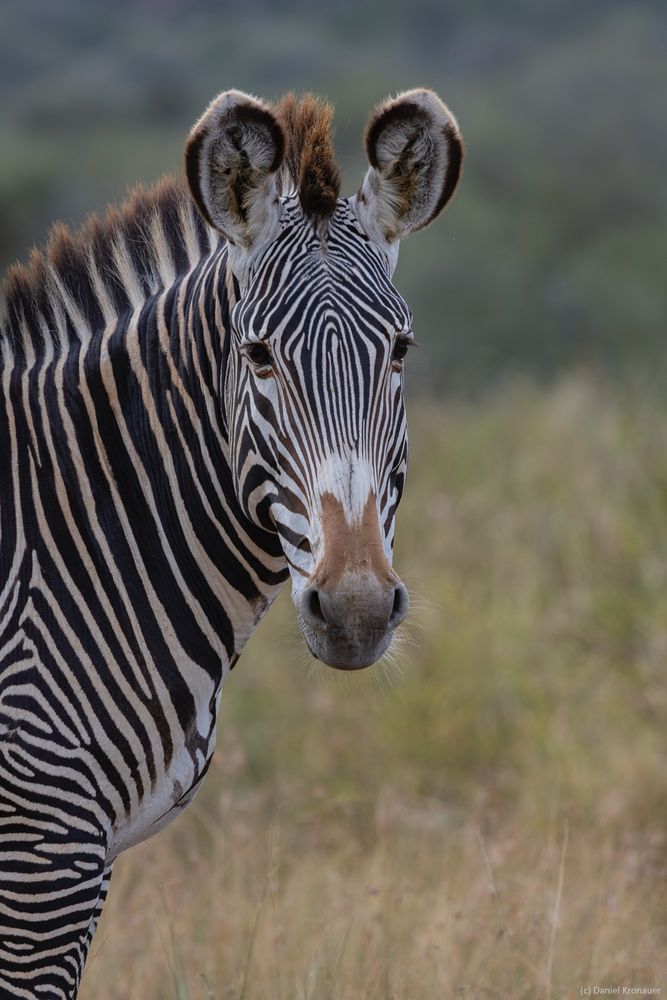

August 14, 2025 at 9:20 AM
The Grévy's zebra (Equus grevyi) is the largest and, sadly, rarest of the three zebra species. Luckily, Mpala Research Centre is home to a decent number of Grévy's zebras, which are studied as part of a long-term monitoring program:
www.mpalalive.org/field_guide/...
mpala.org/princeton-ze...
www.mpalalive.org/field_guide/...
mpala.org/princeton-ze...
A hyrax with its little one. These cutie pies were living right outside our cottage at Mpala Research Centre. 🇰🇪 Apparently it is World Elephant Day. So why hyraxes? Unlikely as it may seem, hyraxes are elephants’ closest living relatives.

August 13, 2025 at 2:39 PM
A hyrax with its little one. These cutie pies were living right outside our cottage at Mpala Research Centre. 🇰🇪 Apparently it is World Elephant Day. So why hyraxes? Unlikely as it may seem, hyraxes are elephants’ closest living relatives.
Some of the animals at Mpala Research Centre 🇰🇪 participate in ongoing projects. Here are vulturine guinea fowl studied by @damienfarine@blsky.social at the MPI for Animal Behaviour. They are individually marked and some are wearing solar-powered GPS tags. More info is here:
mpala.org/vulturine-gu...
mpala.org/vulturine-gu...

August 12, 2025 at 5:11 PM
Some of the animals at Mpala Research Centre 🇰🇪 participate in ongoing projects. Here are vulturine guinea fowl studied by @damienfarine@blsky.social at the MPI for Animal Behaviour. They are individually marked and some are wearing solar-powered GPS tags. More info is here:
mpala.org/vulturine-gu...
mpala.org/vulturine-gu...
The disapproving looks of a barred owl… Woodstock, NY
July 7, 2025 at 5:46 PM
The disapproving looks of a barred owl… Woodstock, NY
Ant fathers are vastly under appreciated. OK, they die right after mating and don’t contribute much to colony life beyond their role as “flying sperm vessels”, but still, a single male can father thousands of daughters. Let’s wish this Camponotus americanus carpenter ant male a Happy Father’s Day.

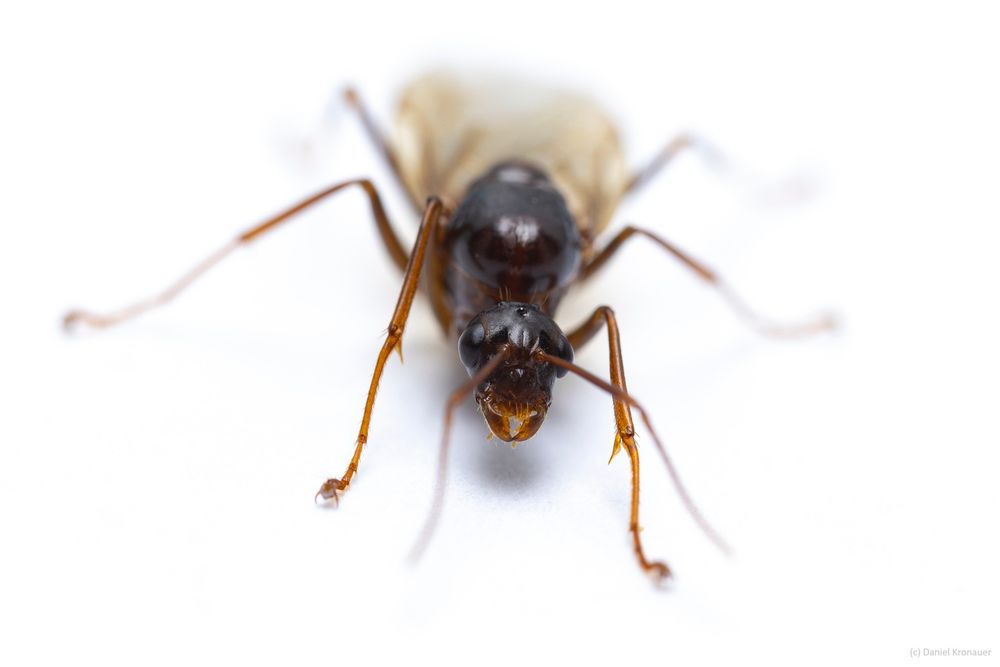
June 16, 2025 at 1:06 AM
Ant fathers are vastly under appreciated. OK, they die right after mating and don’t contribute much to colony life beyond their role as “flying sperm vessels”, but still, a single male can father thousands of daughters. Let’s wish this Camponotus americanus carpenter ant male a Happy Father’s Day.
Happy Father’s Day everyone! This tree swallow (Tachycineta bicolor) is being a good parent by literally stuffing its chick with yummy insects. Woodstock, NY.
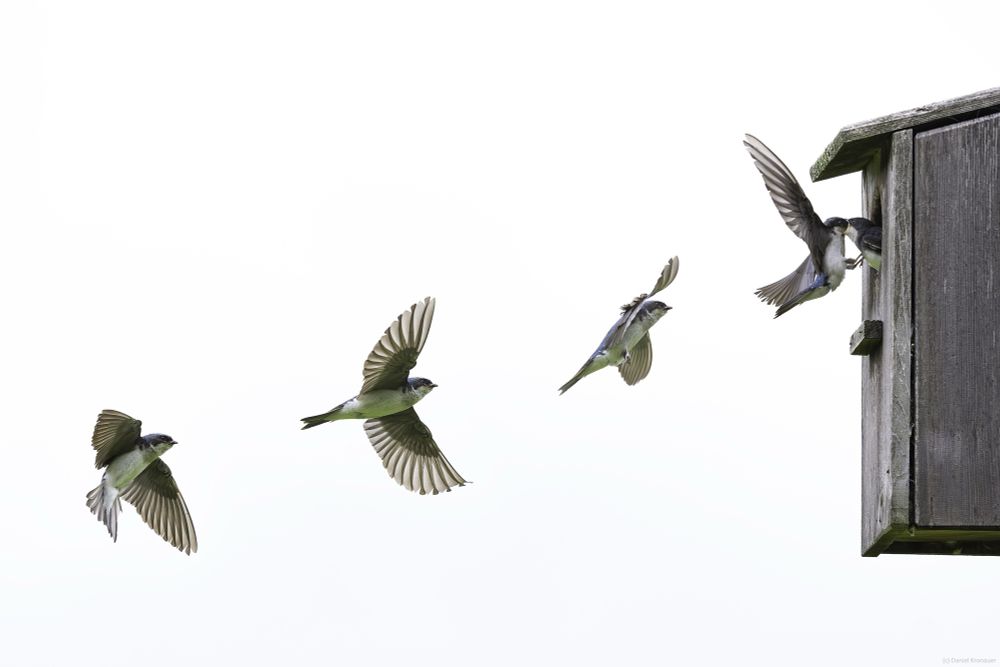
June 16, 2025 at 1:01 AM
Happy Father’s Day everyone! This tree swallow (Tachycineta bicolor) is being a good parent by literally stuffing its chick with yummy insects. Woodstock, NY.
And the prize for best hairdo goes to…drumroll…this bumblebee-mimicking robber fly (Laphria spec.). This dude is such a close mimic it almost fooled me last weekend. These flies are fierce predators of other insects including, well, bees. Thorn Preserve, Woodstock, NY.

June 10, 2025 at 1:23 AM
And the prize for best hairdo goes to…drumroll…this bumblebee-mimicking robber fly (Laphria spec.). This dude is such a close mimic it almost fooled me last weekend. These flies are fierce predators of other insects including, well, bees. Thorn Preserve, Woodstock, NY.
The spiny caterpillar of the Baltimore Checkerspot (Euphydryas phaeton). Named after Lord Baltimore, this species is the official insect of Maryland. Thorn Preserve, Woodstock, NY.
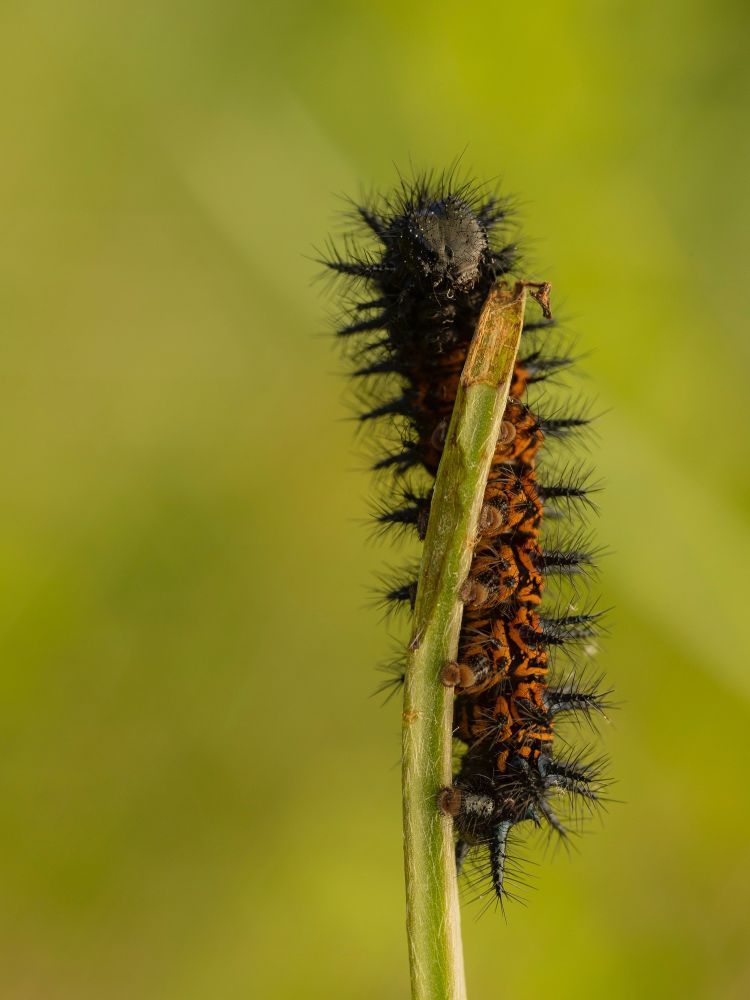
June 9, 2025 at 8:13 PM
The spiny caterpillar of the Baltimore Checkerspot (Euphydryas phaeton). Named after Lord Baltimore, this species is the official insect of Maryland. Thorn Preserve, Woodstock, NY.
Here’s a large Dorylus molestus army ant worker guarding the trail of its colony at Mount Kenya.

June 6, 2025 at 1:50 PM
Here’s a large Dorylus molestus army ant worker guarding the trail of its colony at Mount Kenya.
Many ants were still attacking the slug, and eventually, as a last resort, it dropped to the floor. Out of the frying pan into the fire. The swarm raid below was still going strong, and within seconds, the slug was engulfed by ants. This time with no more defensive mucus left to secrete... 3/3
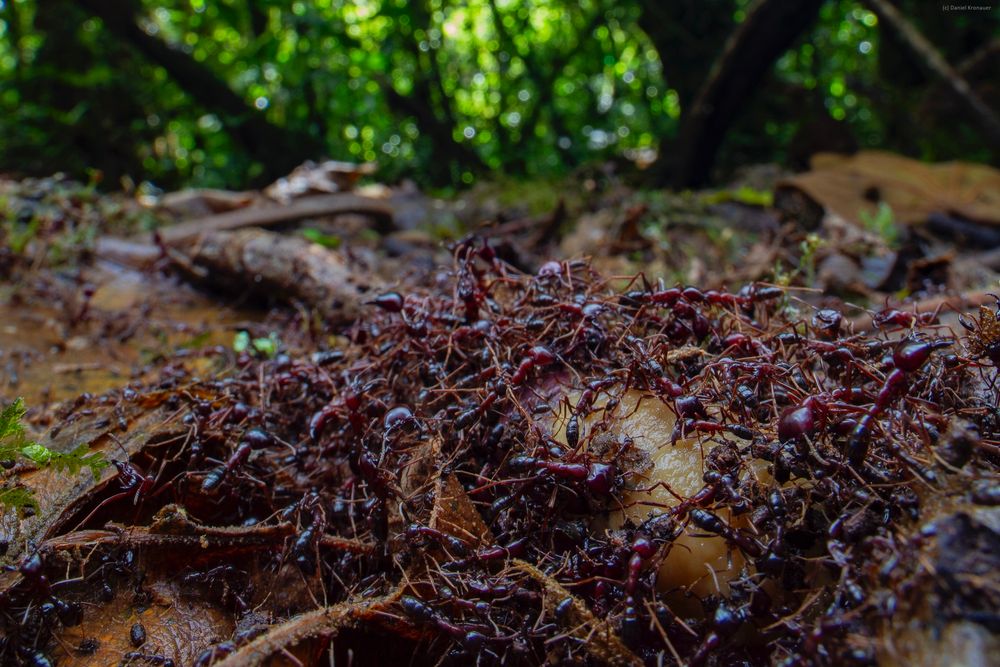
June 5, 2025 at 11:36 PM
Many ants were still attacking the slug, and eventually, as a last resort, it dropped to the floor. Out of the frying pan into the fire. The swarm raid below was still going strong, and within seconds, the slug was engulfed by ants. This time with no more defensive mucus left to secrete... 3/3
This allowed the slug to withstand the ants for about 1.5 hours. However, the ants kept cutting through the mucus, and eventually the slug was forced to emerge and make a “run” for it. Look at all the slime with ants left behind by the slug. 2/3
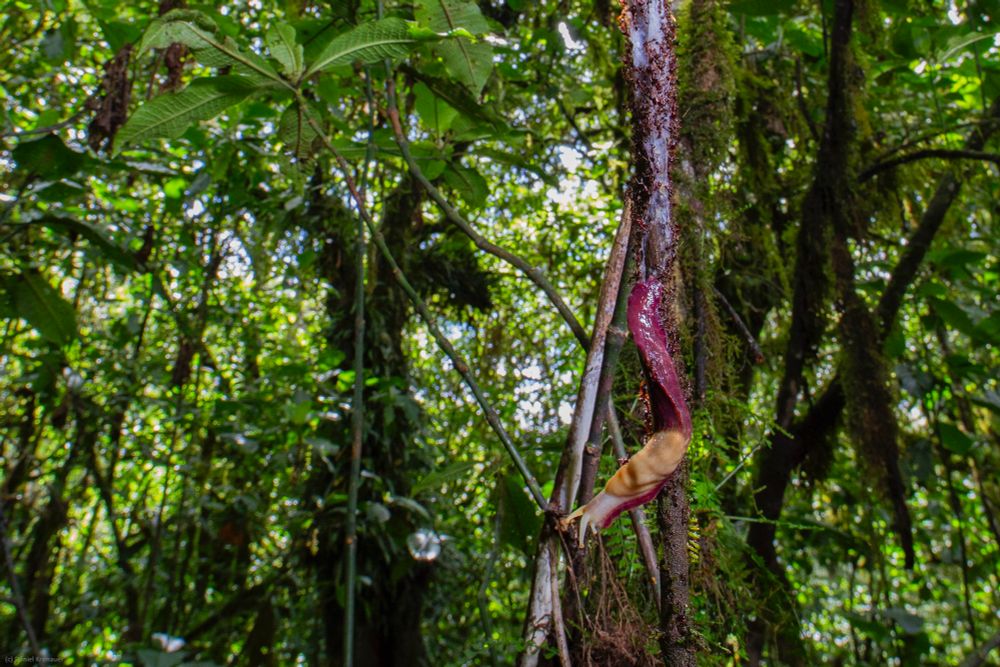
June 5, 2025 at 11:36 PM
This allowed the slug to withstand the ants for about 1.5 hours. However, the ants kept cutting through the mucus, and eventually the slug was forced to emerge and make a “run” for it. Look at all the slime with ants left behind by the slug. 2/3
Here’s a series of pictures from a Dorylus molestus army ant swarm raid at Mount Kenya. At a height of about 1.7 meters up the vegetation, the ants encountered a large slug. The slug initially responded to the ant attack by secreting and encapsulating itself in a thick layer of mucus. 1/3

June 5, 2025 at 11:36 PM
Here’s a series of pictures from a Dorylus molestus army ant swarm raid at Mount Kenya. At a height of about 1.7 meters up the vegetation, the ants encountered a large slug. The slug initially responded to the ant attack by secreting and encapsulating itself in a thick layer of mucus. 1/3
The dogbane leaf beetle (Chrysochus auratus) is an absolute gem. As the name suggests, these beetles eat dogbane, and have adapted to tolerate the plant’s toxins. Thanks to Caroline Chaboo for confirming the ID. Woodstock, NY.
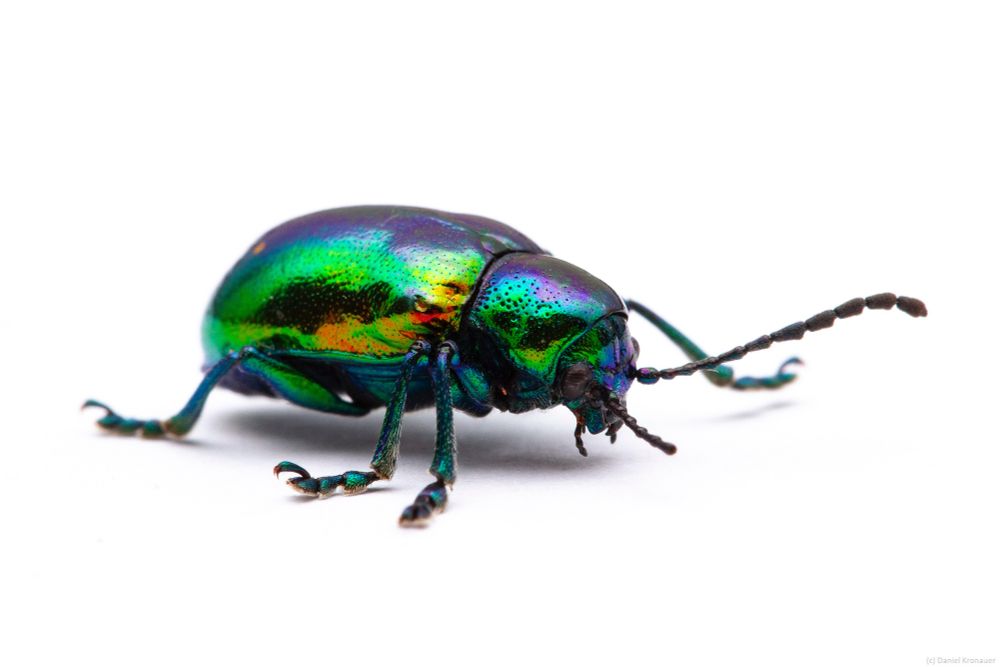
June 2, 2025 at 9:52 PM
The dogbane leaf beetle (Chrysochus auratus) is an absolute gem. As the name suggests, these beetles eat dogbane, and have adapted to tolerate the plant’s toxins. Thanks to Caroline Chaboo for confirming the ID. Woodstock, NY.
Immigrant pavement ants (Tetramorium immigrans) originally hail from Europe but are now common in North America. In the spring, they fight intense territorial battles with neighboring colonies. The first image is a portrait, and the second shows them butchering a caterpillar. Woodstock, NY.
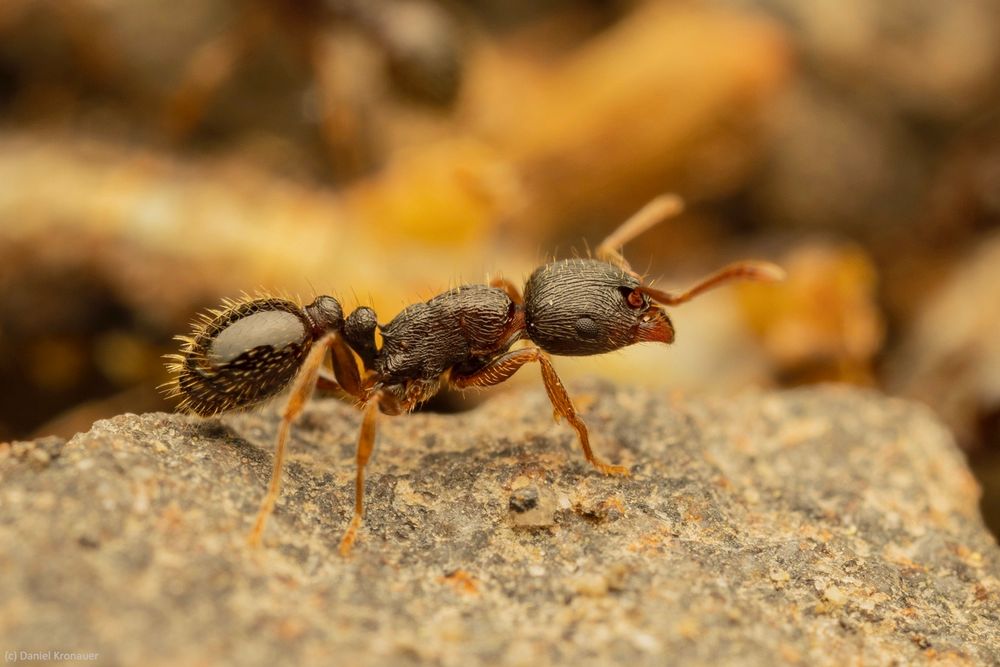
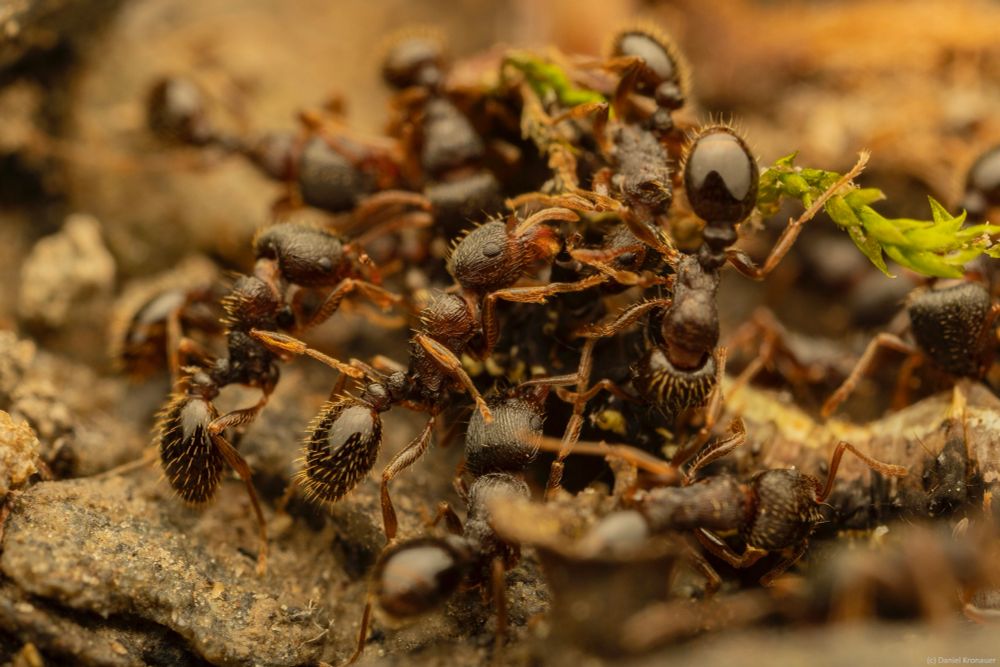
June 1, 2025 at 2:48 PM
Immigrant pavement ants (Tetramorium immigrans) originally hail from Europe but are now common in North America. In the spring, they fight intense territorial battles with neighboring colonies. The first image is a portrait, and the second shows them butchering a caterpillar. Woodstock, NY.
Here are a few more portraits of the myrmecophilous clown beetle Haeterius brunneipennis, a guest of Formica wood ants. Thanks to Alexey Tishechkin for the species ID. Woodstock, NY.

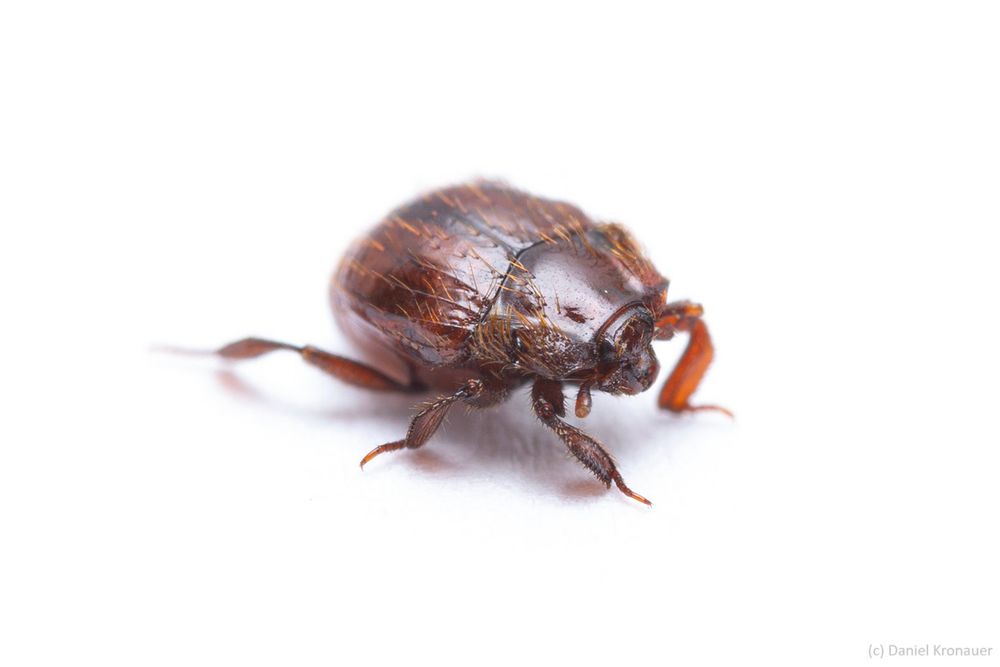
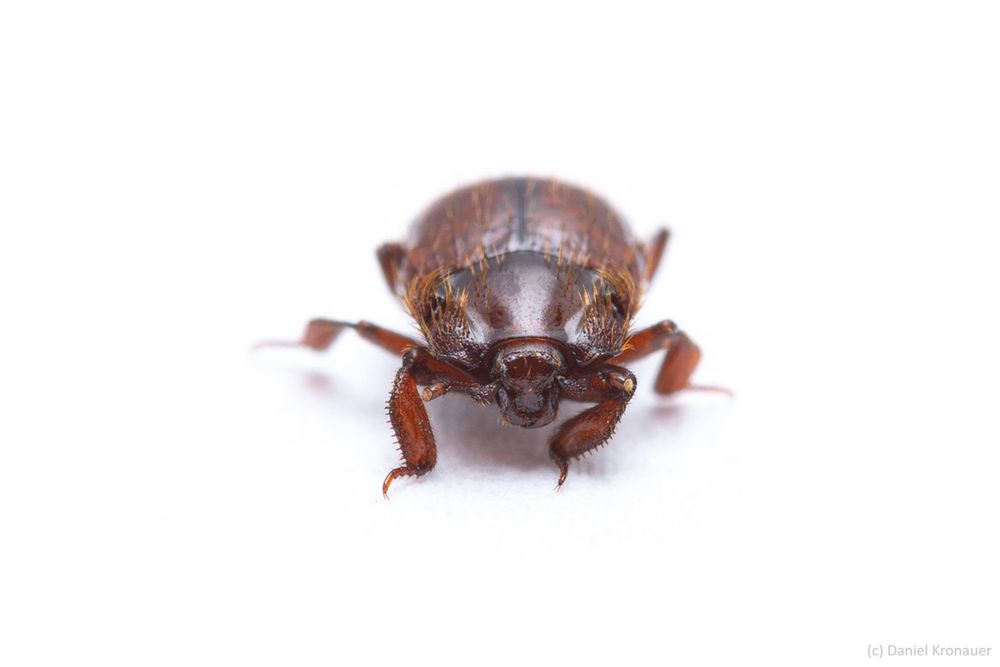
May 31, 2025 at 6:17 AM
Here are a few more portraits of the myrmecophilous clown beetle Haeterius brunneipennis, a guest of Formica wood ants. Thanks to Alexey Tishechkin for the species ID. Woodstock, NY.
Crematogaster acrobat ants have heart-shaped butts, undoubtedly the cutest in the ant world. As the name suggests, they are also very flexible, bending their derrière forward and over the head when upset. Here, they are taking care of their larvae. Woodstock, NY.
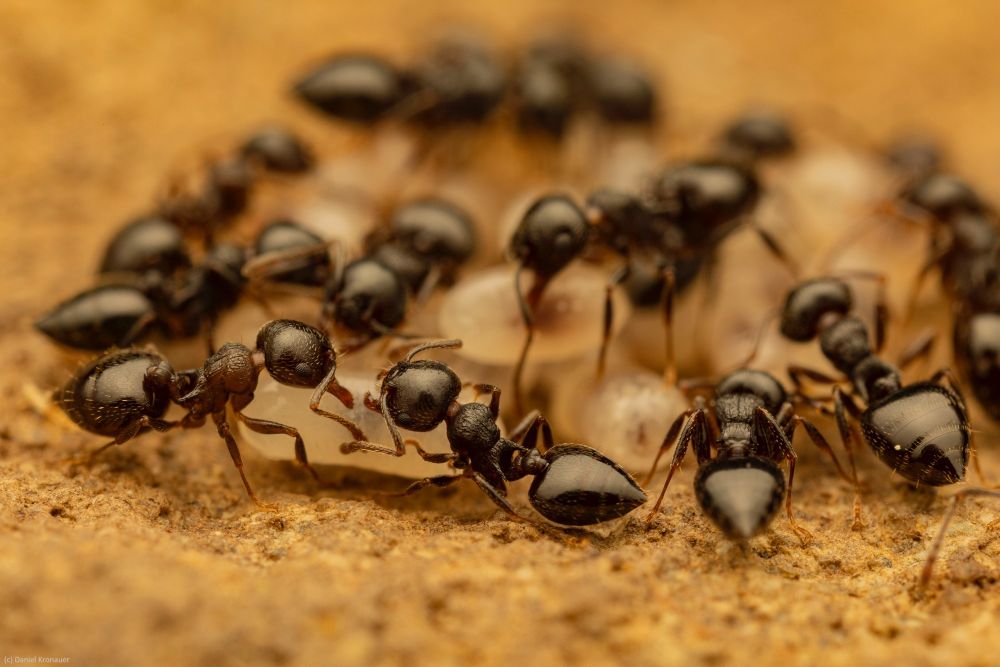
May 30, 2025 at 3:51 PM
Crematogaster acrobat ants have heart-shaped butts, undoubtedly the cutest in the ant world. As the name suggests, they are also very flexible, bending their derrière forward and over the head when upset. Here, they are taking care of their larvae. Woodstock, NY.
Here’s a massive rove beetle, the golden-brown Platydracus maculosus, up to ca. 3 cm in length. An actively hunting predator of other arthropods, this dude looked like an insect version of a Komodo dragon or a honey badger to me. Woodstock, NY.

May 29, 2025 at 2:19 PM
Here’s a massive rove beetle, the golden-brown Platydracus maculosus, up to ca. 3 cm in length. An actively hunting predator of other arthropods, this dude looked like an insect version of a Komodo dragon or a honey badger to me. Woodstock, NY.
The myrmecophilous clown beetle Haeterius lives inside the nests of Formica wood ants. I found this specimen in a mixed colony of Formica sanguinea-group slave-making ants and their Formica fusca-group hosts in my garden. The beetle is just under 2mm long. Woodstock, NY.
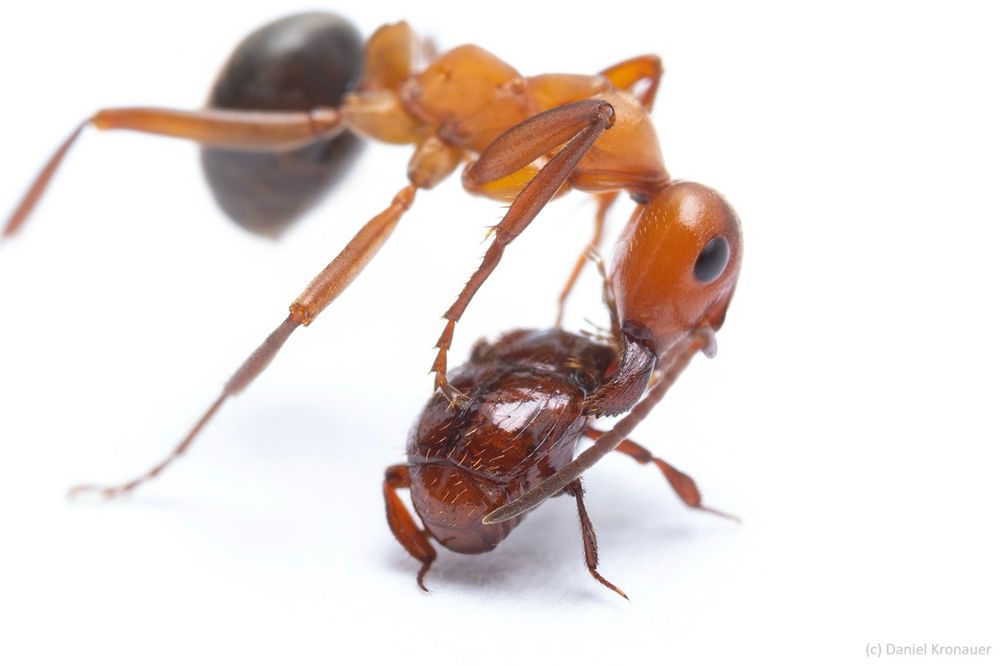
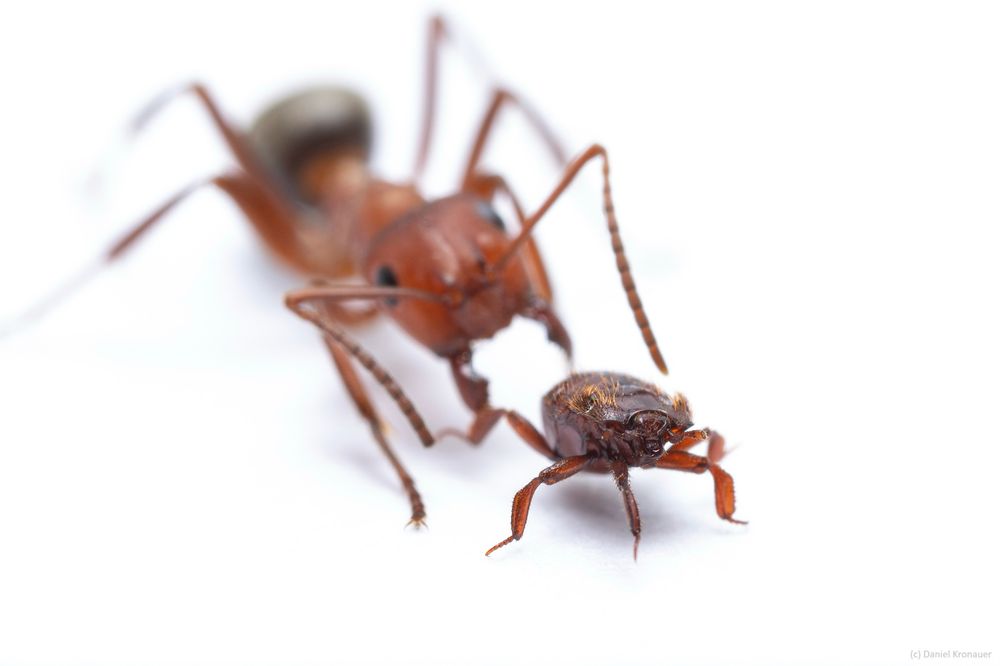
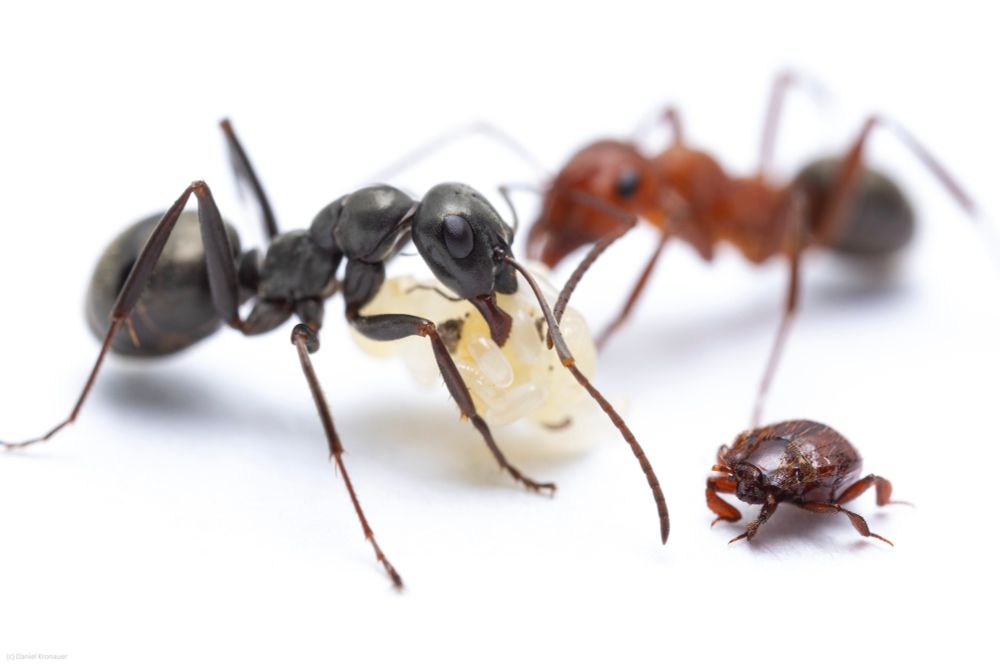
May 28, 2025 at 3:26 PM
The myrmecophilous clown beetle Haeterius lives inside the nests of Formica wood ants. I found this specimen in a mixed colony of Formica sanguinea-group slave-making ants and their Formica fusca-group hosts in my garden. The beetle is just under 2mm long. Woodstock, NY.
In images 2&3 I have removed the foam, which provides protection from predators and desiccation, to reveal the little spittlebug nymph as it is busy bubbling to remake its nest. If you want to learn more, here are some links: (3/3)
www.amnh.org/explore/news...
www.nytimes.com/2019/02/19/s...
www.amnh.org/explore/news...
www.nytimes.com/2019/02/19/s...
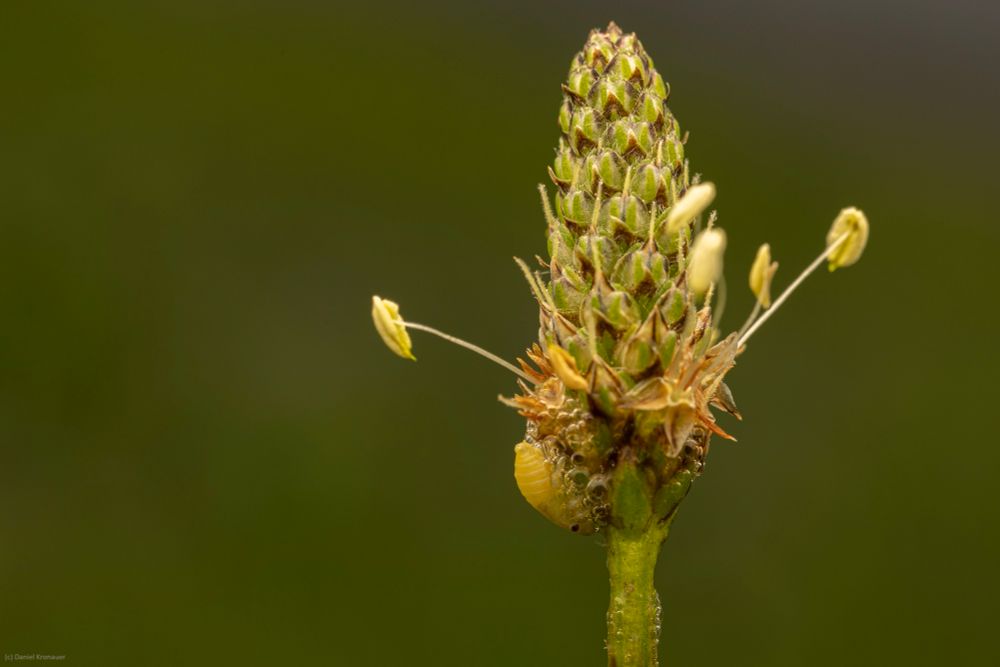
May 27, 2025 at 1:49 PM
In images 2&3 I have removed the foam, which provides protection from predators and desiccation, to reveal the little spittlebug nymph as it is busy bubbling to remake its nest. If you want to learn more, here are some links: (3/3)
www.amnh.org/explore/news...
www.nytimes.com/2019/02/19/s...
www.amnh.org/explore/news...
www.nytimes.com/2019/02/19/s...

